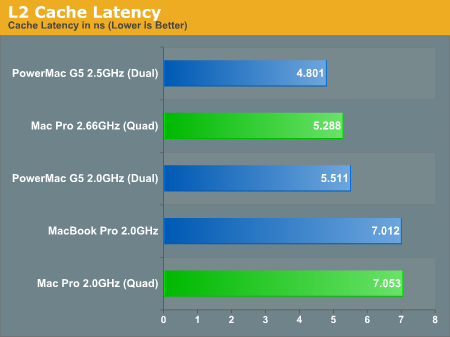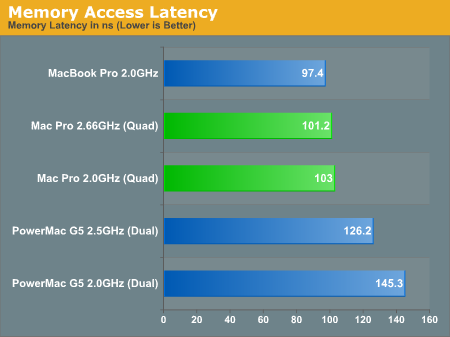Apple's Mac Pro - A True PowerMac Successor
by Anand Lal Shimpi on August 16, 2006 12:27 PM EST- Posted in
- Mac
Memory Performance
We'll start off our look at the Mac Pro's performance with some low level memory tests, since arguably the most controversial aspect of the Mac Pro is its use of Fully Buffered DIMMs. For more information about FB-DIMMs be sure to read our original article on the Mac Pro.

The G5 had a very quick 12-cycle L2 cache, which gives it a slight performance advantage compared to the 14-cycle L2 of the Xeons in the Mac Pro. Access latency is only one part of the puzzle however, as the G5s benchmarked here only had a 512KB L2 cache (the G5 later got an upgrade to a 1MB cache) while the Xeons in the Mac Pro have a 4MB L2 cache per chip. The G5 had a slightly faster L2, but you can reach higher clocks with the Xeon thus minimizing the effective latency and you can fit more data into the larger L2.

And here we see the real killer with FB-DIMMs; although the Mac Pro boasts lower latency memory accesses than the PowerMac G5, it actually takes longer to access main memory than the Core Duo processor in the MacBook Pro. This is much worse than it sounds once you take into account the fact that the MacBook Pro features a 667MHz FSB compared to the 1333MHz FSB (per chip) used in the Mac Pro.
We can further put things in perspective by looking at memory latency under Windows XP, compared to Intel's Core 2 processor. Remember that the Core 2 is identical to the Xeons in the Mac Pro, the difference being that the chipset uses regular DDR2 memory instead of DDR2-667 FB-DIMMs. Note that for our Core 2 system in the comparison below we ran the memory at DDR2-667 at 5-5-5-15 timings as well as DDR2-800 at 4-4-4-12 to provide apples-to-apples as well as apples-to-fastest comparisons.
| CPU | Everest |
CPU-Z 1.35 (8192KB, 256-byte stride) | Everest READ | Everest WRITE |
| Apple Mac Pro 2.66GHz (DDR2-667 FB-DIMM Quad Channel) | 100 ns | 87.4 ns | 4292 MB/s | 3759 MB/s |
| Apple Mac Pro 2.66GHz (DDR2-667 FB-DIMM Dual Channel) | 105.8 ns | 92.3 ns | 4141 MB/s | 3096 MB/s |
| Intel Core 2 Duo E6700 2.66GHz (DDR2-800 4-4-4-12 Dual Channel) | 59.9 ns | 52.8 ns | 7413 MB/s | 4859 MB/s |
| Intel Core 2 Duo E6700 2.66GHz (DDR2-667 5-5-5-15 Dual Channel) | 68.9 ns | 59 ns | 6782 MB/s | 4858 MB/s |
It's not Apple's fault, but FB-DIMMs absolutely kill memory latency; even running in quad channel mode, the FB-DIMM equipped Mac Pro takes 45% more time to access memory than our DDR2 equipped test bed at the same memory frequency. Things don't get any prettier when we look at memory bandwidth either.
Remember the overhead we were worried about with the serialization of parallel memory requests? With four FBD channels, the best we're able to see out of the Mac Pro is 4.292GB/s, compared to the 6.782GB/s of bandwidth our dual channel Core 2 testbed is able to provide. The efficiency table below says it all:
| CPU | Peak Theoretical Bandwidth |
Everest READ | Efficiency |
| Apple Mac Pro 2.66GHz (DDR2-667 FB-DIMM Quad Channel) | 21.3GB/s | 4.292GB/s | 20% |
| Apple Mac Pro 2.66GHz (DDR2-667 FB-DIMM Dual Channel) | 10.67GB/s | 4.141GB/s | 38.8% |
| Intel Core 2 Duo E6700 2.66GHz (DDR2-800 4-4-4-12 Dual Channel) | 12.8GB/s | 7.413GB/s | 57.9% |
| Intel Core 2 Duo E6700 2.66GHz (DDR2-667 5-5-5-15 Dual Channel) | 10.67GB/s | 6.782GB/s | 63.6% |
FB-DIMMs are simply not good for memory performance; the added capacity allowed by having 8 FB-DIMM slots on the Mac Pro had better be worth it, because if Apple were to release a Core 2 based Mac chances are that it could give the Mac Pro a run for its money in a number of memory sensitive tasks.










96 Comments
View All Comments
Anand Lal Shimpi - Wednesday, August 16, 2006 - link
Could you show me how to get Dell to take $149 off for the monitor? Whenever I try to configure it if I select the "No Monitor" option it lists a cost of $0, meaning I don't gain or lose anything.The Dell protection plan is truly enterprise class however the point of the comparison was to look at things from a purely hardware/cost of components perspective, which is how these Mac vs. PC price comparisons are usually done. Once you go above and beyond that then you get into this slippery slope argument of how much you should tack on for the price of being able to run OS X, etc...
Take care,
Anand
delta53 - Wednesday, August 16, 2006 - link
The "they" was referring to Apple namely at the WWDC6, no offence Anand. The option is given under the Medium and Large business section, but your point is well taken that exact price is impossible in that section.Keep up the good reports,
Kyle
Furen - Wednesday, August 16, 2006 - link
I was under the impression that Cinebench had very light memory usage. It looks to me that what will make or break Woodcrest's "power efficiency" is going to be FBDIMM power so perhaps loading up the ram will paint slightly different numbers...TamarinMonkey - Wednesday, August 16, 2006 - link
Now that we can run both OSX and XP on the same hardware, I'd be interested to see some of the benchmarks run on both OSs and see how they do. Any plans to do this in a future article?~Tam~
retrospooty - Wednesday, August 16, 2006 - link
I am pretty sure this has been done, and OSX has been found to be lacking, especially in 3d games. The speed advantage of PC over MAC was not that Intel/AMD were so much faster than IBM G4, then G5, but the OS and drivers are much finer tuned.Tegeril - Wednesday, August 16, 2006 - link
It was definitely not so much about the OS/Drivers being finer tuned in regards to 3D gaming. It was definitely a DirectX versus OpenGL issue.psychobriggsy - Thursday, August 17, 2006 - link
More specifically, Apple's OpenGL implementation on PowerPC was/is severely lacking.I wonder if the Intel Mac OS X drivers are better - i.e., the ATI/Nvidia drivers ported to Mac OS X.
Konq - Monday, September 11, 2006 - link
I just played WoW last night on my Quadro 4500-equiped Mac Pro. An ATI version should be similar. I was in a 40 man raid for my guild. This thing screams in OS X. I get 30-40 fps in a crowded IF, 50-100 fps flying, and I peaked at 135 fps looking at the sky. All at 1920x1200. The drivers sure have improved and I think are better on intel. I have a 2.3 Ghz dual core G5 and this is twice as fast even thought the G5 had a 7800 GT card. Oh - and I never noticed the fans spin up during the raid even though I had low sound volume.Rumor has it that OpenGL will be much improved when it goes multithreaded in 10.4.8. We will see. :)
Konq - Monday, September 11, 2006 - link
I forgot to mention: the Mac Pro loaded the WoW AQ40 instance in about 2 seconds! Faster even the second time. I can't express how impressed I am with this machine.As a side note, I used Office in Rosetta, and it is as fast as my G5. Maybe 4GB of RAM helps here but I was worried after reading Anands' report.
Pirks - Wednesday, August 16, 2006 - link
Please use XP x64 benchmarks as well, since it's uberinteresting to see how both 64-bit OSes from MS and Apple compete. XP 32-bit is okay, but a bit boring.